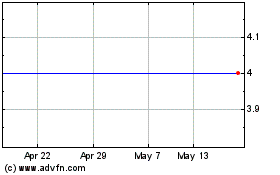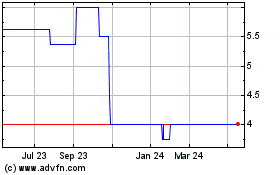Aisi Realty Public Limited Half Yearly Report -12-
September 05 2012 - 2:00AM
UK Regulatory
4.1.3 Property Market price risk
Market price risk is the risk that the value of the Company's
portfolio investments will fluctuate as a result of changes in
market prices. The Group's assets are susceptible to market price
risk arising from uncertainties about future prices of the investments.
The Group's market price risk is managed through diversification
of the investment portfolio, continuous elaboration of the market
conditions and active asset management.
The prevailing global economic conditions throughout 2008-2010
and the ensuing Euro zone Sovereign Debt crisis have had a considerable
effect on the market prices of the current portfolio investments
of the Group.
In cases that the BoD deemed necessary, it has taken provisions
on the assets' valuation in order to ensure that the asset value
is presented within the financial statements of the Group in
such a way as to take into account various uncertainties. To
quantify the value of its assets and/or indicate the possibility
of impairment losses, the Company commissioned internationally
acclaimed valuers.
4.1.4 Interest rate risk
Interest rate risk is the risk that the value of financial instruments
will fluctuate due to changes in market interest rates.
The Group's income and operating cash flows are substantially
independent of changes in market interest rates as the Group
has no significant interest--bearing assets apart from its cash
balances that are mainly kept for liquidity purposes.
The Group is exposed to interest rate risk in relation to its
borrowings. Borrowings issued at variable rates expose the Group
to cash flow interest rate risk. Borrowings issued at fixed rates
expose the Group to fair value interest rate risk. All of the
Group's borrowings are issued at a variable interest rate. Management
monitors the interest rate fluctuations on a continuous basis
and acts accordingly.
4.1.5 Credit risk
Credit risk arises when a failure by counter parties to discharge
their obligations could reduce the amount of future cash inflows
from financial assets at hand at the end of the reporting period.
Cash balances are held with high credit quality financial institutions
and the Group has policies to limit the amount of credit exposure
to any financial institution.
Management has been in continuous discussions with banking institutions
monitoring their ability to extend financing as per the Group's
needs. The sovereign debt crisis has affected the pan-European
banking system during 2011 and has imposed financing uncertainties
for new development projects.
Management also monitors the developing Eurozone debt crisis
situation in respect of its possible effects on the Region's
banking system. More specifically Management evaluates the probability
that the parent Italian, Austrian and Greek banks liquidity related
issues affect negatively the local subsidiaries of the said banks.
4.1.6 Currency risk
Currency risk is the risk that the value of financial instruments
will fluctuate due to changes in foreign exchange rates.
Currency risk arises when future commercial transactions and
recognized assets and liabilities are denominated in a currency
that is not the Group's functional currency. Most of the Group's
transactions, including the rental proceeds are denominated in
the functional currency (USD). For the rest of the foreign exchange
exposure Management monitors the exchange rate fluctuations on
a continuous basis and acts accordingly.
As a precaution against probable depreciation of local currencies,
and especially of the UAH, the majority of the Group's liquid
assets are held in USD denominated deposit accounts.
4.1.7 Capital risk management
The Group manages its capital to ensure that it will be able
to continue as a going concern while maximizing the return to
shareholders through the optimization of the debt and equity
balance. The Group's core strategy is described in note 27 of
the financial statements.
4.1.8 Compliance risk
Compliance risk is the risk of financial loss, including fines
and other penalties, which arises from non--compliance with laws
and regulations of the state.
Although the Group is trying to limit such risk, the uncertain
environment in which it operates increases the complexities handled
by Management. A new compliance policy is expected to be implemented
in 2012.The Group's exposures are discussed under note 27.
4.1.9 Litigation risk
Litigation risk is the risk of financial loss, interruption of
the Group's operations or any other undesirable situation that
arises from the possibility of non--execution or violation of
legal contracts and consequentially of lawsuits. The risk is
restricted through the contracts used by the Group to execute
its operations and is discussed in note 25.
4.1.10 Reputation risk
The risk of loss of reputation arising from the negative publicity
relating to the Group's operations (whether true or false) may
result in a reduction of its clientele, reduction in revenue
and legal cases against the Group. Following the Group's distress
period between 2010 and mid 2011 and the settlement of its known
liabilities Management expects that the risk of negative publicity
is reduced.
4.2. Operational risk
Operational risk is the risk that derives from the deficiencies
relating to the Group's information technology and control systems
as well as the risk of human error and natural disasters. The
Group's systems are evaluated, maintained and upgraded continuously.
4.3 Fair value estimation
The fair values of the Group's financial assets and liabilities
approximate their carrying amounts at the end of the reporting
period.
5. Critical accounting estimates and judgements
The preparation of financial statements in conformity with IFRSs
requires the use of certain critical accounting estimates and
requires Management to exercise its judgement in the process
of applying the Group's accounting policies. It also requires
the use of assumptions that affect the reported amounts of assets
and liabilities and disclosure of contingent assets and liabilities
at the date of the financial statements and the reported amounts
of revenues and expenses during the reporting period. These estimates
are based on Management's best knowledge of current events and
actions and other factors, including expectations of future events
that are believed to be reasonable under the circumstances. Actual
results though may ultimately differ from those estimates.
As the Group makes estimates and assumptions concerning the future
the resulting accounting estimates will, by definition, seldom
equal the related actual results. The estimates and assumptions
that have a significant risk of causing a material adjustment
to the carrying amounts of assets and liabilities within the
next financial year are discussed below:
* Provision for impairment of receivables
The Group reviews its trade and other receivables for evidence
of their recoverability. Such evidence includes the counter party's
payment record, and overall financial position as well as the
state's ability to pay its dues (VAT receivable). If indications
of irrecoverability exist, the recoverable amount is estimated
and a respective provision for impairment of receivables is made.
The amount of the provision is charged through profit or loss.
The review of credit risk is continuous and the methodology and
assumptions used for estimating the provision are reviewed regularly
and adjusted accordingly.
-- Fair value of investment property
The fair value of investment property is determined by using
various valuation techniques. The Group selects highly reputed
international companies with local presence to effect such valuations.
Such valuers use their judgement to select a variety of methods
and make assumptions that are mainly based on market conditions
existing at each financial reporting date. The fair value of
the investment property has been estimated based on the fair
value of their individual assets.
* Income taxes
Significant judgement is required in determining the provision
for income taxes. There are transactions and calculations for
which the ultimate tax determination is uncertain during the
ordinary course of business. The Group recognises liabilities
for anticipated tax audit issues based on estimates of whether
additional taxes will be due. Where the final tax outcome of
these matters is different from the amounts that were initially
recorded, such differences will impact the income tax and deferred
tax provisions in the period in which such determination is made.
* Impairment of tangible assets
Assets that are subject to depreciation are reviewed for impairment
whenever events or changes in circumstances indicate that the
carrying amount may not be recoverable. An impairment loss is
recognized for the amount by which the asset's carrying amount
exceeds its recoverable amount. The recoverable amount is the
higher of an asset's fair value less costs to sell and value
in use. For the purposes of assessing impairment, assets are
grouped at the lowest levels for which there are separately identifiable
cash flows (cash-generating units).
* Impairment of intangible assets
Secure Property Developm... (LSE:SPDI)
Historical Stock Chart
From Jun 2024 to Jul 2024

Secure Property Developm... (LSE:SPDI)
Historical Stock Chart
From Jul 2023 to Jul 2024
